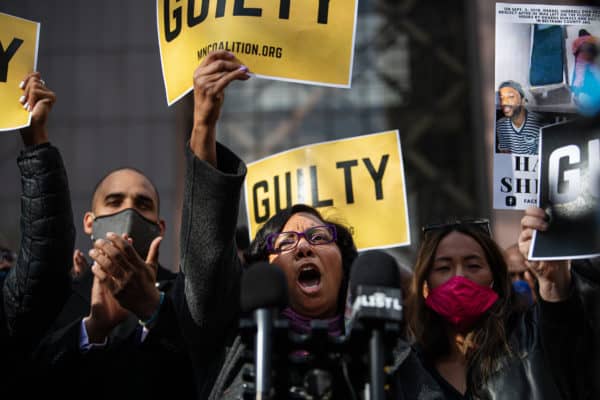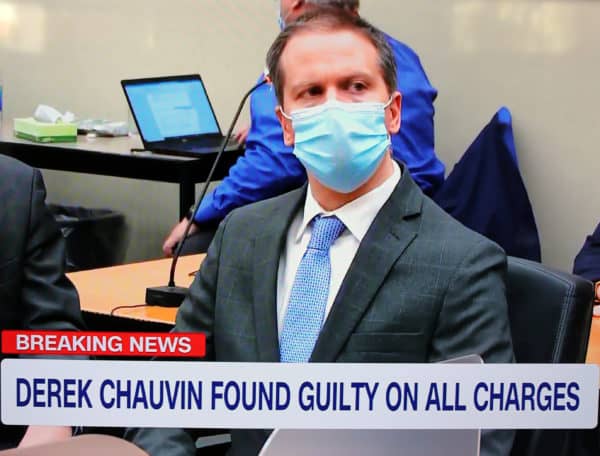The Derek Chauvin Trial — Day 16
Anastasia Katz, American Renaissance, April 21, 2021

Del Shea Perry, mother of deceased Hardel Sherrell, during a press conference after the news that former police officer Derek Chauvin was found guilty on all three charges in the murder of George Floyd on April 20, 2021 in Minneapolis, Minnesota. (Credit Image: © Joel Marklund / Bildbyran via ZUMA Press)
Editor’s Note: See our coverage of the first day of the trial here, the second day here, the third day here, the fourth day here, the fifth day here, the sixth day here, the seventh day here, the eighth day here, the ninth day here, the tenth day here, the eleventh day here, the twelfth day here, the thirteenth day here, the fourteenth day here, and the fifteenth day here.
Outside the Hennepin County Courthouse on Tuesday morning, a crowd chanted, “If George don’t get it, SHUT IT DOWN! If George don’t get it, SHUT IT DOWN!” while the jurors deliberated inside. Although 14 jurors heard the case, Judge Peter Cahill excused the two alternates after closing arguments on Monday, and Jurors #96 and #118 went home.
The remaining 12 jurors began deliberating on Monday evening and continued into Tuesday, returning with a verdict after ten and a half hours. Judge Cahill read the verdict: Derek Chauvin was found guilty on all three counts: second-degree murder, third-degree murder, and second-degree manslaughter.
As the crowd outside the courthouse began to celebrate, Mr. Chauvin watched as Judge Cahill asked the jurors, one-by-one, if these were their “true and correct” verdicts. Each juror said, “Yes.” The judge thanked and excused the jury.

Credit Image: © Pool Video Via HLN/ZUMA Wire
Judge Cahill then informed Mr. Chauvin and his lawyer, Eric Nelson, that sentencing will be in eight weeks. Mr. Chauvin’s bail was revoked, and he was remanded into custody of the sheriff. Mr. Chauvin was the model of compliance as he was handcuffed and led out of the courtroom, unlike the man who now has both a city square and pending legislation named after him.
Here are charges the jury found Mr. Chauvin guilty of “beyond a reasonable doubt.”
Count One: Murder in the Second Degree in connection with the death of George Floyd.
Definition: Under Minnesota law, a person causing the death of another person, without intent to cause the death of any person, while committing or attempting to commit a felony offense is guilty of the crime of Murder in the Second Degree.
Each count is broken down into “Elements” that must be met. The elements for second-degree murder are:
- The death of George Floyd must be proven.
- The Defendant caused the death of George Floyd.
- The Defendant, at the time of causing the death of George Floyd, was committing or attempting to commit the felony offense of Assault in the Third Degree. It is not necessary for the State to prove the Defendant had an intent to kill George Floyd, but it must prove that the defendant committed or attempted to commit the underlying felony of Assault in the Third Degree.
- The Defendant’s act took place on or about May 25, 2020 in Hennepin County.
Elements One and Four were obviously met, and proven with George Floyd’s death certificate.
The jury was given definitions to help them understand Elements Two and Three. The definition of “caused the death” was:
The Defendant’s act or acts were a substantial causal factor in causing the death of George Floyd. . . The fact that other causes contribute to the death does not relieve the Defendant of criminal liability. However, the Defendant is not criminally liable if a “superseding cause” caused the death. A “superseding cause” is a cause that comes after the Defendant’s acts, alters the natural sequence of events, and is the sole cause of a result that would not otherwise have occurred.
If the jury believed Mr. Chauvin’s weight on Floyd’s body was the foremost reason why Floyd died, Floyd’s poor heart and drug intake would not relieve Mr. Chauvin of criminal liability, even if the jury felt those things played a role and contributed to Floyd’s death.
Element Three is complicated, as it entails a crime within a crime. The jury had to believe that Mr. Chauvin was committing Assault in the Third Degree, which has two elements:
- Defendant assaulted George Floyd. “Assault” is the intentional infliction of bodily harm upon another or the attempt to inflict bodily harm upon another. The intentional infliction of bodily harm required proof that the Defendant intentionally applied unlawful force to another person without that person’s consent and that this act resulted in bodily harm.
- Defendant inflicted substantial bodily harm on George Floyd. It is not necessary for the State to prove that the Defendant intended to inflict substantial bodily harm, or knew that his actions would inflict substantial bodily harm, only that the Defendant intended to commit the assault and that George Floyd sustained substantial bodily harm as a result of the assault.
In short, Element One requires that Mr. Chauvin purposely inflicted pain or injury on Floyd. One can argue that as a police officer restraining a suspect, there was no intent. However, if the jury found Mr. Chauvin’s use of force unlawful, Element One would fit. Any police officer using the “pain compliance” techniques that were described during the trial would meet Element One. Officers are taught to apply pain to someone resisting arrest, and the idea is that the pain will stop when the subject complies with the police officer.
Element Two requires that Floyd suffered a substantial injury, and there need not be proof that Mr. Chauvin intended to cause it. Unintentionally causing Floyd’s death would satisfy the requirement for Element Two.
Before the verdict came in, Court TV hostess Julie Grant conducted a phone interview with legal scholar Alan Dershowitz, famous for defending O.J. Simpson. Mr. Dershowitz was concerned about the implications of Mr. Chauvin being convicted of second-degree murder.
If the prosecution’s theory prevails in this case, then every killing automatically becomes second degree murder, because every time you shoot somebody and kill somebody, you also assault them. . . And if assault becomes the underlying felony, which it is not in almost every other state, and not under the American Law Institute, and not under any form of scholarship — If you allow the underlying felony to be an assault, then you eliminate the degrees of murder. . . Every time somebody shoots someone, and that results in death, it will be the highest degree of murder, felony murder, because every shooting entails an assault.
Count Two: Murder in the Third Degree in connection with the death of George Floyd.
Definition: Under Minnesota law, a person causing the death of another by perpetrating an act eminently dangerous to others, and evincing a depraved mind, without regard for human life, but without intent to cause the death of any person.
Elements:
- The death of George Floyd must be proven.
- The Defendant caused the death of George Floyd.
- The Defendant caused the death of George Floyd by an intentional act that was eminently dangerous to other persons. . . The act is highly likely to cause death.
- Defendant acted with a mental state consisting of reckless disregard for human life. The defendant’s act may not have been specifically intended to cause death, and may not have been specifically directed at the person who died, but must have been committed with a conscious indifference to the loss of life that the dangerous act could cause.
- The defendant’s act took place on or about May 25, 2020 in Hennepin County.
Mr. Dershowitz explained on Court TV that Murder in the Third Degree is typically used when someone shoots into a crowded area.
Count Three: Manslaughter in the Second Degree in connection with the death of George Floyd.
Definition: Under Minnesota law, whoever, by culpable negligence, whereby he creates an unreasonable risk and consciously takes the chance of causing death or great bodily harm to another person, causes the death of another, is guilty of Manslaughter in the Second Degree.
Elements:
- Death of George Floyd must be proven.
- Defendant caused the death of George Floyd by culpable negligence whereby the defendant created an unreasonable risk and consciously took a chance of causing death. . . The defendant may not have intended to be harmful, but an ordinary and reasonably prudent person would recognize that as involving a strong probability of injury to others.
- Must have happened in Hennepin County.
Mr. Dershowitz told Miss Grant that he did not think either Second Degree or Third Degree Murder made sense in this case. He quoted Thomas Jefferson: “A criminal statute must be so clear that a person of reason has to be able to understand it, if he reads it while running.” Mr. Dershowitz said:
Now I read this while sitting, having taught criminal law for 50 years and done 250 appeals in criminal cases — I do not understand either the second degree or third degree murder statutes to apply to the allegations in this case. Manslaughter fits it to a “T,” but second and third degree murder do not seem to cover the conduct at issue here.
Mr. Dershowitz was very critical of Judge Cahill for not sequestering the jury from the beginning, and of the fact that Minnesota vs. Derek Chauvin became so politicized. “There has never been a case like this,” he said. “This is much, much bigger than O.J. Simpson, or any of the other cases that I have been involved in. And the idea that . . . the jury should be allowed to participate in the claim that this should be a referendum — juries don’t vote on referendum. They vote on proof beyond a reasonable doubt of the elements of the specific offense against a specific individual. . . Their role is very conflicted now.”















